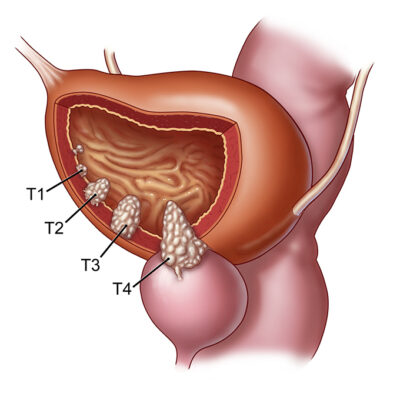Bladder cancer is a relatively common malignancy in the urinary tract.
This type of cancer occurs in people aged 50 to 70 years. It can be caused by exposure to certain chemicals. Cigarette smoking is the most common cause of bladder cancer – the more an individual smokes, the higher their likelihood of developing bladder cancer.
Most patients with bladder cancer will not require major surgery – nowadays endoscopic (“keyhole”) surgery is used to manage most cases. Bladder cancer is a disease with a high rate of recurrence – most patients will remain on long-term surveillance after treatment.
Passing blood in the urine is usually the first symptom of bladder cancer. The blood in the urine can be obvious to the eye (ie red- or pink coloured urine) or may only be detected on routine urine tests done for other purposes. The presence of blood in the urine does not mean that a person definitely has bladder cancer – other causes of blood in the urine include urinary tract infections and kidney stones. Seeing blood in your urine is a reason to urgently see a Urologist.
How is bladder cancer diagnosed?
Any of the following tests may be performed to confirm the presence of a tumor in the bladder:
- Urine tests: To detect cancer cells in the urine and check for infection.
- Blood tests: To check your kidney function.
- Cystoscopy: A look inside your bladder with a special camera to assess for any abnormal growths within the bladder. A sample / biopsy may also be taken during cystoscopy to confirm the presence of cancer.
- Sonar/ultrasound scan: The bladder and kidneys are checked for the presence of abnormal masses or lumps.
- CT scan: To give more detailed information about the urinary system and possible cancer spread.
What happens if a tumor or abnormal growth is found inside your bladder?
When an abnormal growth is found inside the bladder, it needs to be cut out / resected. This surgical procedure is called “Trans-urethral Resection of Bladder Tumor” (TURBT). Surgically removing the mass will not only clear the bladder of this growth, but the resected tissue will be sent to the pathology laboratory for analysis and identification. This will give essential information regarding the type of growth, whether it is cancerous or not, its aggressiveness, and how far it has grown. For each individual patient, this information will determine the further management.
The initial surgical removal of the growth inside the bladder (TURBT) is performed under general- or spinal anaesthesia. During the procedure, special cameras and small instruments are passed through the urethra / bladder pipe. No incisions on the skin are needed – this is referred to as minimally invasive- or endoscopic surgery. Although this is not major surgery, you will likely still need to spend 1 night in hospital afterward.
What happens after the initial surgery / TURBT?
Further treatment depends on the results obtained from the pathology laboratory after your TURBT. The pathologist’s report will indicate the aggressiveness of the bladder cancer and also how far it had spread at the time of diagnosis. Depending on these variables, further treatment may include:
- Follow up only with camera checks of the bladder every 3 to 6 months.
- Further resection (TURBT) of growths inside the bladder.
- Chemotherapy placed inside the bladder.
- Surgical removal of the entire bladder (called “radical cystectomy”) – this is a major surgical procedure.
- Radiation treatment.
- Chemotherapy.

